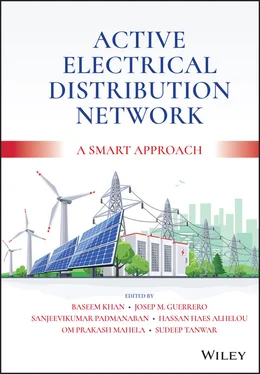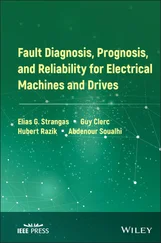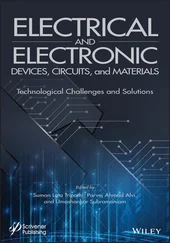Active Electrical Distribution Network
Здесь есть возможность читать онлайн «Active Electrical Distribution Network» — ознакомительный отрывок электронной книги совершенно бесплатно, а после прочтения отрывка купить полную версию. В некоторых случаях можно слушать аудио, скачать через торрент в формате fb2 и присутствует краткое содержание. Жанр: unrecognised, на английском языке. Описание произведения, (предисловие) а так же отзывы посетителей доступны на портале библиотеки ЛибКат.
- Название:Active Electrical Distribution Network
- Автор:
- Жанр:
- Год:неизвестен
- ISBN:нет данных
- Рейтинг книги:5 / 5. Голосов: 1
-
Избранное:Добавить в избранное
- Отзывы:
-
Ваша оценка:
- 100
- 1
- 2
- 3
- 4
- 5
Active Electrical Distribution Network: краткое содержание, описание и аннотация
Предлагаем к чтению аннотацию, описание, краткое содержание или предисловие (зависит от того, что написал сам автор книги «Active Electrical Distribution Network»). Если вы не нашли необходимую информацию о книге — напишите в комментариях, мы постараемся отыскать её.
Discover the major issues, solutions, techniques, and applications of active electrical distribution networks with this edited resource Active Electrical Distribution Network: A Smart Approach
Active Electrical Distribution Network: A Smart Approach
Active Electrical Distribution Network — читать онлайн ознакомительный отрывок
Ниже представлен текст книги, разбитый по страницам. Система сохранения места последней прочитанной страницы, позволяет с удобством читать онлайн бесплатно книгу «Active Electrical Distribution Network», без необходимости каждый раз заново искать на чём Вы остановились. Поставьте закладку, и сможете в любой момент перейти на страницу, на которой закончили чтение.
Интервал:
Закладка:
High technical losses in distribution.
No theft handling mechanism.
No proper fault handling mechanism.
Lack of sourcing and management.
Overstaffing.
Poor collection efficiency.
High rate of outages, blackouts, device failures, etc.
Losses are not established.
Commercial losses are not accountable.
No outage handling and transactional mechanisms.
Lack of enterprise resource planning (ERP) practice.
Poor managerial efficiency.
High fiscal deficit.
No asset management and facility management.
High political interferences.
1.3.2 Privately Owned DISCOMs
In this case, the ownership of the distribution lies with a private company. As a measure of private participation and introducing competition, the following steps were implemented:
More than two licensees were allowed to sell power in the same area.
Provision was made for different tariff rates based on different technical factors like load demand, voltage demand, power factor, etc.
Licensees were allowed to do other business required for optimal utilization of assets but with prior permission.
The relative concerns with this model are:
The private companies started running the power distribution business without bothering government norms and provisions.
They failed to protect consumer interests.
The tariff rate was high.
They faced political resistance as privatization is not welcome in public services.
The number of consumer protests increased.
1.3.3 Public–Private Partnership (PPP) Model
By leaving the distribution business totally in the hands of private players, government lost its control on the distribution sector and was not able to interfere when some norms or guidelines were being violated by the private companies. As a result, different governments kept some share in the distribution utility instead of giving the entire stake to the private player. This initiative led to the development of the concept of a Public–Private Partnership (PPP) model in the power distribution business. The PPP model encompasses various functions and obligations related to electricity supply in a licensed area. In the case of the PPP model, competitive bidding is the criteria used to select the concessionaire. Selected players would be responsible for operation, management, and maintenance related works. Apart from these tasks, the electricity supply, loss reduction, and looking after the interest of the consumers by maintaining quality of supply are also taken care by the concessionaire [8]. The ownership of the assets is not given to the concessionaire, rather the exclusive use of the distribution assets is allowed. Concession agreement and the applicable laws regulate the use of distribution assets.
The relative concerns with this model are:
Tariff will be fixed separately for the PPP project area; this will bring multiple tariffs in the same state.
May face political resistant as privatization is not welcome in public services.
The PPP model needs attention for structuring, as it is complex in nature, so more conscious efforts are required from the government.
The tariff may be different for urban and rural areas, so for uniform tariffs the government needs to provide subsidies.
1.3.4 Distribution Franchisee (DF) Model
This model is a hybrid arrangement between a concession and a management contract, which enables private players to carry out some power-related functions without letting the ownership of the distribution sector go to the private player. In the case of the DF model, a distribution licensee is legally allowed through the regulatory provisions to authorize a person/entity for electricity distribution in a specific area under its licensee area [9]. Table 1.1shows the various forms of a DF model.
Table 1.1 Various forms of DF model.
| Franchisee model | Compensation | Area | Benefit to power sector |
|---|---|---|---|
| OutsourcingOutsourcing of some of the activities like billing and collection | Fixed fee | Rural | Improved operational efficiency |
| Collection-based revenue franchisee (CBRF)Allowed for billing and collection | Provisions for incentives and penalties based on collection while ensuring fixed percentage of collection toward compensation of labor used | Rural | Improved operational and collection efficiency |
| Revenue collection with O&MOperation and maintenance related responsibilities in addition to billing and collection | Fixed fee and incentive | Rural | Improved operational and collection efficiency Reduction in manpower |
| Input-based distribution franchisee (IBDF)Perform the same tasks as that of a distribution licensee except it must buy electricity from the licensee at some predecided input rates | Right on revenue | Urban | Improved operational and collection efficiency Reduction in manpower and distribution losses Avoided investments |
These four DF models all have their own popularity. The selection of a particular model is highly dependent upon the area of its implementation. For example, in rural areas, meter reading and bill distribution using vending machines, revenue collection, etc., compels the involvement of the franchisee. For this purpose the franchisee is given to individuals, panchayatiraj (the local government in the Indian subcontinent) institutions, self-help groups (SHGs), non-governmental organizations (NGOs), or groups of customers. Thus the first three models of DF models are suitable for operations in rural areas. However, in the case of the IBDF, the operational area is mostly preferred to be the urban area and the franchisee is assigned to undertake the functions of operation and maintenance along with the above tasks. Beside these activities, a franchisee is also allowed to undertake capital expenditure (CAPEX) for its allowed area. In the case of an IBDF franchisee scheme, the franchisee has to buy electricity from the distribution licensee at some predefined input rates, which are decided based on a competitive bidding process. Figure 1.4 shows the structure of an input-based distribution franchisee (IBDF) model.

Figure 1.4 Input-based franchisee model.
Again, the input rate is decided by the licensee based on a loss reduction trajectory. As the tariff is the imposed control on a franchisee to reduce AT&C losses, the main objective of the franchisee is to reduce AT&C losses in its network. Thus the profit label of the franchisee totally depends upon its performance toward reducing losses as framed in a performance-based multiyear tariff framework. If the franchisee is not able to achieve the targeted loss reduction, it is also penalized and suffers from the loss. As a result, the primary focus of the DF model has shifted toward loss reduction. The DF model has tremendous potential toward reducing losses, improving collection efficiencies, and is synonymous with a privately owned DISCOM. Because of these features, this model has attracted lot of interest by various utilities. Involvement of private companies reduces the political interference and ensures adequate private capital investment. The relative concerns with this model involve:
The takeover time is too long as the transition of asset and manpower requires an audit.
Bid norms are such that only big players get a chance and therefore bidding is very restrictive: bidding talent becomes a problem.
Читать дальшеИнтервал:
Закладка:
Похожие книги на «Active Electrical Distribution Network»
Представляем Вашему вниманию похожие книги на «Active Electrical Distribution Network» списком для выбора. Мы отобрали схожую по названию и смыслу литературу в надежде предоставить читателям больше вариантов отыскать новые, интересные, ещё непрочитанные произведения.
Обсуждение, отзывы о книге «Active Electrical Distribution Network» и просто собственные мнения читателей. Оставьте ваши комментарии, напишите, что Вы думаете о произведении, его смысле или главных героях. Укажите что конкретно понравилось, а что нет, и почему Вы так считаете.











